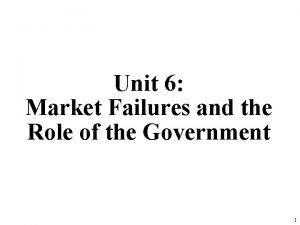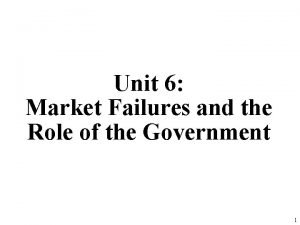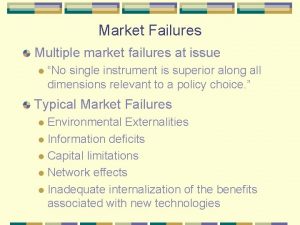Chapter 9 Market and Government Failures Market Failures






- Slides: 6

Chapter 9 Market and Government Failures

Market Failures – Cases where the market can not achieve economic efficiency n Externalities – by-products or side effects that affect a third party n n n n n Social Benefits don’t equal Social Costs Types Negative – pollution, congestion n If externalities are included supply shifts to the left and prices rise Positive – flu shots n Demand shifts to the right and prices rise Internalizing Taxes or fees Regulation Market rights Public Goods – produced by the government and paid for with taxes n n Characteristics Nonrival (joint consumption) – my use doesn’t interfere with your use Nonexcludable – on one can be excluded Indivisble Example – roads, schools, military, police, fire department Hard to determine payments and use of individuals n Private sector can’t provide them n n n

n n n n Regulation – rules on business activities Types n Economic – pricing, marketing and profits n Social –worker safety, food and drugs, environment Alters behavior Antitrust Laws – prevent monopolies and anticompetitive behavior Post civil war trusts were formed n Interlocking directorates Laws were passed n Sherman Act (1890) – Anti-monopoly act n Price fixing n Clayton Act (1914) – Unfair business practices n Interlocking directorates n Price discrimination n Federal Trade Act (1914) – created FTC n Unfair methods of competition n Cutthroat pricing Enforcement n Market Share test – 70% of the market, firm has substantial market power n Relevant market n Based on n Product - substitutes n Geography

Government Financing n Taxation n Rates n n n Marginal tax rate = change in total taxes/change in total income Average tax rate = total taxes/total income Systems n n Proportional – as income rises, rate same Progressive - as income rises, rate rises Regressive - as income rises, rate falls

Government Failures – where government intervenes with a negative result n Reduces competition n Improper pricing of health care services n Inefficient regulation Systems Public Choice: Voting n n Why we Paradox n 3 n 2 don’t vote: MC > MB of Voting candidates projects, 3 voters Natural Resources and Pollution Switching Point Maximum Sustainable Yield n n n n Fees Licenses Quotas Seasons Recycling

Income Distribution n Marginal Productivity n Talent Experience Training Education – human capital n n n n Each degree earned has a higher average income Inheritance Discrimination











